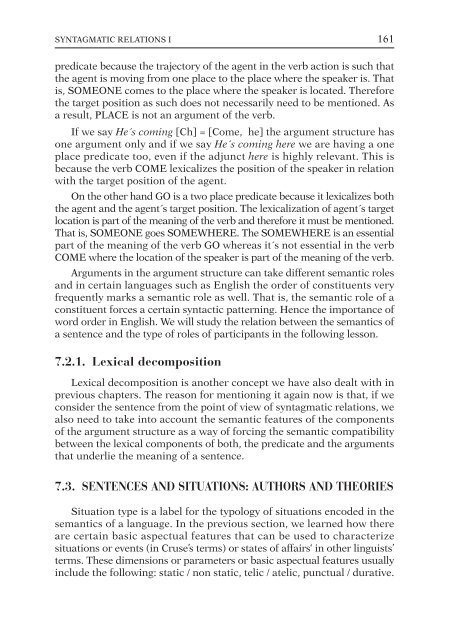Semantics
You also want an ePaper? Increase the reach of your titles
YUMPU automatically turns print PDFs into web optimized ePapers that Google loves.
SYNTAGMATIC RELATIONS I 161<br />
predicate because the trajectory of the agent in the verb action is such that<br />
the agent is moving from one place to the place where the speaker is. That<br />
is, SOMEONE comes to the place where the speaker is located. Therefore<br />
the target position as such does not necessarily need to be mentioned. As<br />
a result, PLACE is not an argument of the verb.<br />
If we say He´s coming [Ch] = [Come, he] the argument structure has<br />
one argument only and if we say He´s coming here we are having a one<br />
place predicate too, even if the adjunct here is highly relevant. This is<br />
because the verb COME lexicalizes the position of the speaker in relation<br />
with the target position of the agent.<br />
On the other hand GO is a two place predicate because it lexicalizes both<br />
the agent and the agent´s target position. The lexicalization of agent´s target<br />
location is part of the meaning of the verb and therefore it must be mentioned.<br />
That is, SOMEONE goes SOMEWHERE. The SOMEWHERE is an essential<br />
part of the meaning of the verb GO whereas it´s not essential in the verb<br />
COME where the location of the speaker is part of the meaning of the verb.<br />
Arguments in the argument structure can take different semantic roles<br />
and in certain languages such as English the order of constituents very<br />
frequently marks a semantic role as well. That is, the semantic role of a<br />
constituent forces a certain syntactic patterning. Hence the importance of<br />
word order in English. We will study the relation between the semantics of<br />
a sentence and the type of roles of participants in the following lesson.<br />
7.2.1. Lexical decomposition<br />
Lexical decomposition is another concept we have also dealt with in<br />
previous chapters. The reason for mentioning it again now is that, if we<br />
consider the sentence from the point of view of syntagmatic relations, we<br />
also need to take into account the semantic features of the components<br />
of the argument structure as a way of forcing the semantic compatibility<br />
between the lexical components of both, the predicate and the arguments<br />
that underlie the meaning of a sentence.<br />
7.3. SENTENCES AND SITUATIONS: AUTHORS AND THEORIES<br />
Situation type is a label for the typology of situations encoded in the<br />
semantics of a language. In the previous section, we learned how there<br />
are certain basic aspectual features that can be used to characterize<br />
situations or events (in Cruse’s terms) or states of affairs‘ in other linguists’<br />
terms. These dimensions or parameters or basic aspectual features usually<br />
include the following: static / non static, telic / atelic, punctual / durative.



